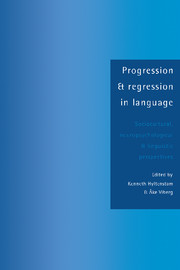 Progression and Regression in Language
Progression and Regression in Language Book contents
- Frontmatter
- Contents
- List of contributors
- Preface
- INTRODUCTION
- THE SOCIOCULTURAL SETTING
- PSYCHO- AND NEUROLINGUISTIC ASPECTS
- THE LINGUISTIC PERSPECTIVE 1: DISCOURSE, GRAMMAR, AND LEXIS
- 10 Crosslinguistic perspectives on native language acquisition
- 11 Syntactic development in Danish L2
- 12 The weaker language in bilingual Swedish-French children
- 13 Four operating principles and input distribution as explanations for underdeveloped and mature morphological systems
- 14 Crosslinguistic perspectives on lexical organization and lexical progression
- 15 Attrition or expansion? Changes in the lexicon of Finnish and American adult bilinguals in Sweden
- THE LINGUISTIC PERSPECTIVE 2: PHONOLOGY
- Index
12 - The weaker language in bilingual Swedish-French children
Published online by Cambridge University Press: 06 July 2010
- Frontmatter
- Contents
- List of contributors
- Preface
- INTRODUCTION
- THE SOCIOCULTURAL SETTING
- PSYCHO- AND NEUROLINGUISTIC ASPECTS
- THE LINGUISTIC PERSPECTIVE 1: DISCOURSE, GRAMMAR, AND LEXIS
- 10 Crosslinguistic perspectives on native language acquisition
- 11 Syntactic development in Danish L2
- 12 The weaker language in bilingual Swedish-French children
- 13 Four operating principles and input distribution as explanations for underdeveloped and mature morphological systems
- 14 Crosslinguistic perspectives on lexical organization and lexical progression
- 15 Attrition or expansion? Changes in the lexicon of Finnish and American adult bilinguals in Sweden
- THE LINGUISTIC PERSPECTIVE 2: PHONOLOGY
- Index
Summary
BACKGROUND
Bilingual children
Studies of grammatical development in young bilingual children have mostly concentrated on the cases where the children have a more or less balanced proficiency in two languages (cf. De Houwer, 1987, and most of the papers in Meisel, 1990). There are however studies of bilingual children aged 1–5 which mention that the two languages are not quite in balance during their development, but that, at least for periods of time, one of the languages is weaker (e.g. Leopold, 1939–49; Arnberg, 1981; Lanza, 1988). Normally the majority language will be the stronger one, whereas the minority language is weaker.
Studies of bilinguals also indicate that if the two languages are both equally strong (Meisel, 1989), each language develops in the same way as the same language of a monolingual child. We do not know very much, however, about the quality of the weaker language. Does it develop like a normal first language, but with some retardation? Or does it develop more like a second language? According to some authors (e.g. De Houwer, 1987; Berman, 1979; Parodi, 1990) the weaker language is retarded in relation to the stronger one, and later follows the same development as a normal first language.
However, owing to the fact that the child may have acquired certain concepts in the stronger language, we can also expect him/her to be influenced by these in the acquisition of the weaker, i.e. the later, one, and thus transfer this similarly to a second language.
- Type
- Chapter
- Information
- Progression and Regression in LanguageSociocultural, Neuropsychological and Linguistic Perspectives, pp. 289 - 308Publisher: Cambridge University PressPrint publication year: 1994
